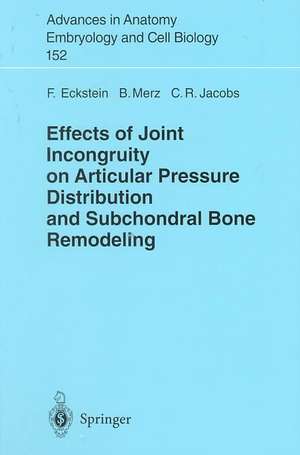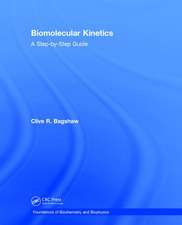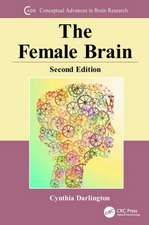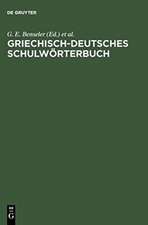Effects of Joint Incongruity on Articular Pressure Distribution and Subchondral Bone Remodeling: Advances in Anatomy, Embryology and Cell Biology, cartea 152
Autor F. Eckstein, B. Merz, C.R. Jacobsen Limba Engleză Paperback – 18 apr 2000
Din seria Advances in Anatomy, Embryology and Cell Biology
- 5%
 Preț: 1146.33 lei
Preț: 1146.33 lei - 5%
 Preț: 721.19 lei
Preț: 721.19 lei - 15%
 Preț: 637.13 lei
Preț: 637.13 lei -
 Preț: 381.81 lei
Preț: 381.81 lei - 15%
 Preț: 644.95 lei
Preț: 644.95 lei - 5%
 Preț: 1025.16 lei
Preț: 1025.16 lei - 15%
 Preț: 689.97 lei
Preț: 689.97 lei - 15%
 Preț: 577.07 lei
Preț: 577.07 lei - 15%
 Preț: 580.36 lei
Preț: 580.36 lei - 5%
 Preț: 393.51 lei
Preț: 393.51 lei -
 Preț: 408.66 lei
Preț: 408.66 lei -
![Die Schlüpfdrüse der Geburtshelferkröte (Alytes o. obstetricans [LAURENTI]) und anderer Froschlurche](https://i4.books-express.ro/bs/9783662239742/die-schluepfdruese-der-geburtshelferkroete-alytes-o-obstetricans-laurenti-und-anderer-froschlurche.jpg) Preț: 408.27 lei
Preț: 408.27 lei - 5%
 Preț: 1090.61 lei
Preț: 1090.61 lei - 5%
 Preț: 705.11 lei
Preț: 705.11 lei - 5%
 Preț: 706.04 lei
Preț: 706.04 lei - 5%
 Preț: 357.61 lei
Preț: 357.61 lei - 5%
 Preț: 704.59 lei
Preț: 704.59 lei - 5%
 Preț: 705.11 lei
Preț: 705.11 lei - 5%
 Preț: 359.42 lei
Preț: 359.42 lei - 5%
 Preț: 711.52 lei
Preț: 711.52 lei - 15%
 Preț: 635.47 lei
Preț: 635.47 lei - 15%
 Preț: 631.72 lei
Preț: 631.72 lei - 15%
 Preț: 633.35 lei
Preț: 633.35 lei - 15%
 Preț: 632.37 lei
Preț: 632.37 lei - 5%
 Preț: 706.60 lei
Preț: 706.60 lei - 15%
 Preț: 631.07 lei
Preț: 631.07 lei - 5%
 Preț: 707.13 lei
Preț: 707.13 lei - 5%
 Preț: 707.33 lei
Preț: 707.33 lei - 5%
 Preț: 359.60 lei
Preț: 359.60 lei - 5%
 Preț: 707.69 lei
Preț: 707.69 lei - 5%
 Preț: 707.13 lei
Preț: 707.13 lei - 5%
 Preț: 708.06 lei
Preț: 708.06 lei - 5%
 Preț: 706.41 lei
Preț: 706.41 lei - 5%
 Preț: 708.78 lei
Preț: 708.78 lei - 5%
 Preț: 705.68 lei
Preț: 705.68 lei - 5%
 Preț: 705.11 lei
Preț: 705.11 lei - 5%
 Preț: 706.77 lei
Preț: 706.77 lei - 15%
 Preț: 635.15 lei
Preț: 635.15 lei - 15%
 Preț: 631.07 lei
Preț: 631.07 lei - 5%
 Preț: 706.77 lei
Preț: 706.77 lei - 5%
 Preț: 706.04 lei
Preț: 706.04 lei - 5%
 Preț: 710.79 lei
Preț: 710.79 lei - 5%
 Preț: 705.32 lei
Preț: 705.32 lei - 15%
 Preț: 633.19 lei
Preț: 633.19 lei - 15%
 Preț: 629.09 lei
Preț: 629.09 lei - 15%
 Preț: 633.53 lei
Preț: 633.53 lei - 15%
 Preț: 632.70 lei
Preț: 632.70 lei - 15%
 Preț: 633.68 lei
Preț: 633.68 lei - 18%
 Preț: 773.72 lei
Preț: 773.72 lei - 15%
 Preț: 630.43 lei
Preț: 630.43 lei
Preț: 363.79 lei
Preț vechi: 382.95 lei
-5% Nou
Puncte Express: 546
Preț estimativ în valută:
69.61€ • 72.94$ • 57.55£
69.61€ • 72.94$ • 57.55£
Carte tipărită la comandă
Livrare economică 12-26 aprilie
Preluare comenzi: 021 569.72.76
Specificații
ISBN-13: 9783540662129
ISBN-10: 354066212X
Pagini: 140
Ilustrații: X, 130 p. 25 illus.
Dimensiuni: 155 x 235 x 7 mm
Greutate: 0.3 kg
Ediția:Softcover reprint of the original 1st ed. 2000
Editura: Springer Berlin, Heidelberg
Colecția Springer
Seria Advances in Anatomy, Embryology and Cell Biology
Locul publicării:Berlin, Heidelberg, Germany
ISBN-10: 354066212X
Pagini: 140
Ilustrații: X, 130 p. 25 illus.
Dimensiuni: 155 x 235 x 7 mm
Greutate: 0.3 kg
Ediția:Softcover reprint of the original 1st ed. 2000
Editura: Springer Berlin, Heidelberg
Colecția Springer
Seria Advances in Anatomy, Embryology and Cell Biology
Locul publicării:Berlin, Heidelberg, Germany
Public țintă
ResearchCuprins
1 Introduction and Questions.- 2 Basis for the Design of the Computer Models.- 2.1 Qualitative and Quantitative Description of Joint Incongruity.- 2.2 Finite Element Method.- 2.3 Theory of Mechanoadaptive Bone Remodeling.- 3 Materials and Methods.- 3.1 Idealized Model of Concave Joint Incongruity.- 3.2 Idealized Comparative Geometric Models.- 3.3 Anatomically Based Model of the Humeroulnar Joint.- 3.4 Experimental Validation.- 3.5 Morphological Investigations on the Elbow Joint.- 4 Results.- 4.1 Idealized Model of Concave Joint Incongruity.- 4.2 Idealized Comparative Geometric Models.- 4.3 Anatomically Based Model of the Humeroulnar Joint.- 4.4 Experimental Validation.- 4.5 Morphological Findings at the Elbow Joint.- 5 Discussion.- 5.1 Methodological Discussion.- 5.2 Effect of the Incongruity on the Pressure in the Joint.- 5.3 The Relationship Between Joint Incongruity, Mechanoadaptive Bone Remodeling and the Morphology of the Subchondral Bone.- 5.4 Phylogenetic and Ontogenetic Origin of Joint Incongruity.- 5.5 Perspectives and Further Investigations.- 6 Conclusions.- References.- Achnowledgements.
Textul de pe ultima copertă
This book reviews the existing literature on joint incongruity, on cellular mechano-transduction of bone, on computer simulations of biological adaptation processes and on embryonic joint development. It describes finite element models and biomechanical experiments that attempt to quantify the effect of joint incongruity on load transmission and on subchondral mineralisation in human articulations and shows that the natural incongruity has profound effects on biomechanicas and connective tissue adaptation of human joints. The present study addresses investigators from different fields (biology, medicine as well as bio-engineering) who study the development, morphology, biomechanics and function of human joints.






